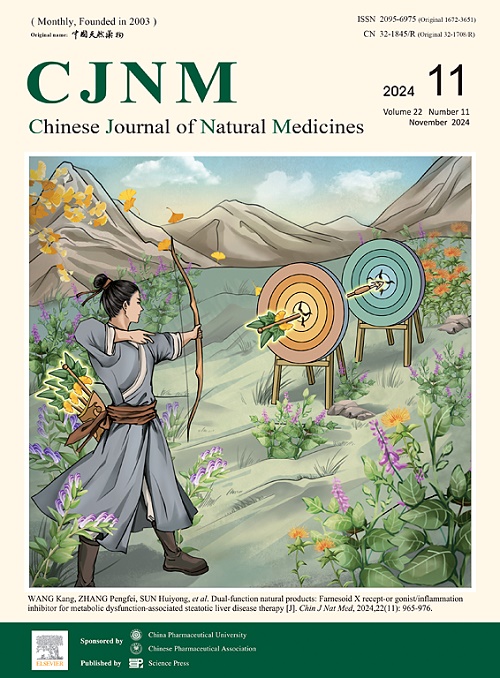从甲壳虫体内分离出的田桥链霉菌 BYF-112 产生的抗菌和细胞毒性代谢物
IF 4
2区 医学
Q1 INTEGRATIVE & COMPLEMENTARY MEDICINE
引用次数: 0
摘要
通过对与白蚁相关的链霉菌(Streptomyces tanashiensis BYF-112)进行化学研究,发现了四种新型生物碱衍生物:vegfrecines A 和 B(1 和 2)、efoliazone A(3)和 venezueline H(7),此外还有九种已知的代谢物(4-6、8-13)。通过全面的光谱分析以及与现有文献数据的比较,这些化合物的结构得以阐明。抗菌试验显示,病毒霉素 A (11) 对金黄色葡萄球菌具有很强的抗菌活性,抑制区(ZOI)为 12.67 毫米,而阳性对照硫酸庆大霉素的抑制区(ZOI)为 17.67 毫米。病毒霉素 A(11)对四联微球菌和鞘氨醇假单胞菌 pv. actinidae 具有中等活性,ZOI 值分别为 15.50 和 14.33 毫米,低于硫酸庆大霉素(34.67 和 24.00 毫米)。病毒霉素 F (12) 对金黄色葡萄球菌、四联霉素霉菌和金黄色葡萄球菌也有中等程度的抗菌效果,ZOI 值分别为 8.33、16.50 和 10.83 mm。细胞毒性试验表明,viridobruunine A (5)、efoliazone (6)、viridomycin A (11) 和 X-14881E (13) 对人类恶性黑色素瘤(A375)、卵巢癌(SKOV-3)和胃癌(MGC-803)细胞系具有显著的细胞毒性,IC50 值范围为 4.61 至 19.28 μmol-L-1。此外,对 S. tanashiensis 完整基因组的生物信息学分析表明,一个假定的生物合成基因簇(BGC)负责生产 1-12 号化合物。这些研究结果表明,昆虫伴生 S. tanashiensis BYF-112 的次级代谢产物有望成为新型抗菌剂和抗癌剂的潜在来源。本文章由计算机程序翻译,如有差异,请以英文原文为准。
Antibacterial and cytotoxic metabolites produced by Streptomyces tanashiensis BYF-112 isolated from Odontotermes formosanus
Chemical investigations of the termite-associated Streptomyces tanashiensis BYF-112 resulted in the discovery of four novel alkaloid derivatives: vegfrecines A and B (1 and 2), exfoliazone A (3), and venezueline H (7), in addition to nine known metabolites (4−6, 8−13). The structures of these compounds were elucidated through comprehensive spectroscopic analysis and comparison with existing literature data. Antibacterial assays revealed that viridomycin A (11) exhibited potent antibacterial activity against Staphylococcus aureus, with a zone of inhibition (ZOI) of 12.67 mm, in comparison to a ZOI of 17.67 mm for the positive control gentamicin sulfate. Viridomycin A (11) showed moderate activity against Micrococcus tetragenus and Pseudomonas syringae pv. actinidae, with ZOI values of 15.50 and 14.33 mm, respectively, which were inferior to those of gentamicin sulfate (34.67 and 24.00 mm). Viridomycin F (12) also exhibited moderate antibacterial effects against S. aureus, M. tetragenus, and P. syringae pv. actinidae, with ZOI values of 8.33, 16.50, and 10.83 mm, respectively. Cytotoxicity assays demonstrated that viridobruunine A (5), exfoliazone (6), viridomycin A (11), and X-14881E (13) exhibited significant cytotoxicity against human malignant melanoma (A375), ovarian cancer (SKOV-3), and gastric cancer (MGC-803) cell lines, with IC50 values ranging from 4.61 to 19.28 μmol·L−1. Furthermore, bioinformatic analysis of the complete genome of S. tanashiensis suggested a putative biosynthetic gene cluster (BGC) responsible for the production of compounds 1−12. These findings indicate that the secondary metabolites of insect-associated S. tanashiensis BYF-112 hold promise as potential sources of novel antibacterial and anticancer agents.
求助全文
通过发布文献求助,成功后即可免费获取论文全文。
去求助
来源期刊

Chinese Journal of Natural Medicines
INTEGRATIVE & COMPLEMENTARY MEDICINE-PHARMACOLOGY & PHARMACY
CiteScore
7.50
自引率
4.30%
发文量
2235
期刊介绍:
The Chinese Journal of Natural Medicines (CJNM), founded and sponsored in May 2003 by China Pharmaceutical University and the Chinese Pharmaceutical Association, is devoted to communication among pharmaceutical and medical scientists interested in the advancement of Traditional Chinese Medicines (TCM). CJNM publishes articles relating to a broad spectrum of bioactive natural products, leading compounds and medicines derived from Traditional Chinese Medicines (TCM).
Topics covered by the journal are: Resources of Traditional Chinese Medicines; Interaction and complexity of prescription; Natural Products Chemistry (including structure modification, semi-and total synthesis, bio-transformation); Pharmacology of natural products and prescription (including pharmacokinetics and toxicology); Pharmaceutics and Analytical Methods of natural products.
 求助内容:
求助内容: 应助结果提醒方式:
应助结果提醒方式:


